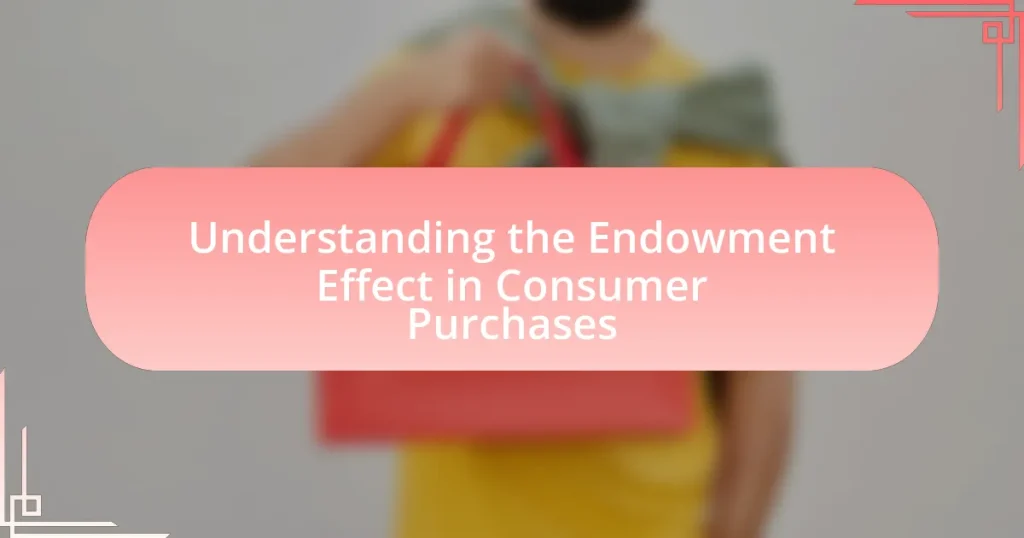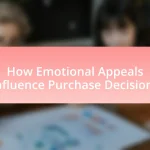The Endowment Effect is a psychological phenomenon where individuals assign greater value to items they own compared to those they do not, significantly influencing consumer behavior and decision-making. This article explores the mechanisms behind the Endowment Effect, including loss aversion and emotional attachment, and its implications for marketing strategies and pricing. It also examines how ownership impacts perceived value, consumer satisfaction, and loyalty, while addressing the limitations and demographic variations of the effect. Additionally, the article provides practical strategies for consumers to mitigate the Endowment Effect in their purchasing decisions, promoting more rational and informed choices.
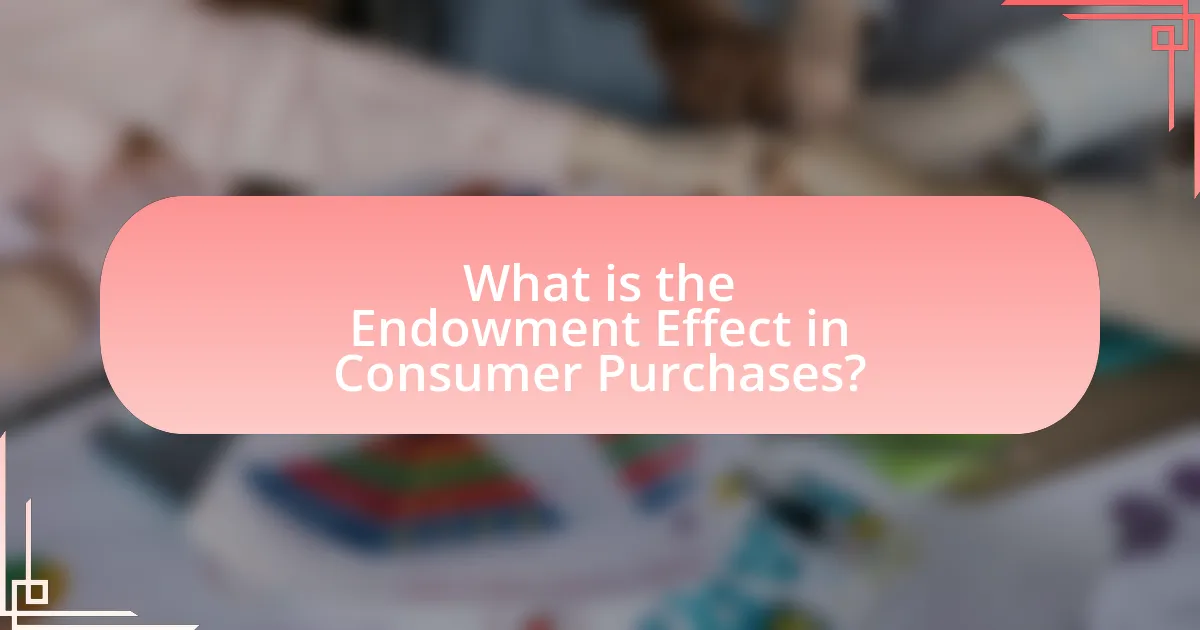
What is the Endowment Effect in Consumer Purchases?
The Endowment Effect in consumer purchases refers to the psychological phenomenon where individuals assign greater value to items they own compared to items they do not own. This effect leads consumers to overvalue their possessions, often resulting in reluctance to sell or trade them, even when market value suggests otherwise. Research by Kahneman, Knetsch, and Thaler in 1990 demonstrated this effect through experiments showing that participants valued items they owned significantly higher than identical items they did not own, illustrating how ownership can distort perceived value.
How does the Endowment Effect influence consumer behavior?
The Endowment Effect significantly influences consumer behavior by causing individuals to assign greater value to items they own compared to identical items they do not own. This psychological phenomenon leads consumers to overvalue possessions, which can result in reluctance to sell or trade items, even when market conditions suggest a different valuation. Research by Kahneman, Knetsch, and Thaler in 1990 demonstrated that participants were willing to pay significantly more to retain a mug they owned than they would pay to acquire the same mug if they did not own it, illustrating the disparity in perceived value based on ownership. This effect can lead to suboptimal decision-making in purchasing and selling behaviors, as consumers may hold onto items longer than rational economic theory would predict.
What psychological mechanisms underlie the Endowment Effect?
The psychological mechanisms underlying the Endowment Effect include loss aversion, the mere ownership effect, and the impact of emotional attachment. Loss aversion, a principle from prospect theory, posits that individuals experience losses more intensely than equivalent gains, leading them to overvalue items they own. The mere ownership effect suggests that simply owning an item increases its perceived value, as individuals attribute greater worth to possessions than to non-possessions. Emotional attachment further amplifies this effect, as personal connections to items can enhance their perceived value, making individuals reluctant to part with them. Research by Kahneman, Knetsch, and Thaler in 1990 demonstrated these mechanisms through experiments showing that participants valued items they owned significantly higher than identical items they did not own, confirming the influence of these psychological factors on consumer behavior.
How does ownership impact perceived value in consumer purchases?
Ownership significantly increases perceived value in consumer purchases due to the endowment effect, where individuals assign greater worth to items they own compared to those they do not. This psychological phenomenon is supported by research indicating that ownership creates an emotional attachment, leading consumers to overvalue their possessions. For instance, a study by Kahneman, Knetsch, and Thaler in 1990 demonstrated that participants valued items they owned much higher than identical items they did not own, illustrating how ownership alters valuation. This effect can influence purchasing decisions, as consumers may be less willing to sell or part with items they own, further reinforcing the perceived value associated with ownership.
Why is the Endowment Effect significant in marketing strategies?
The Endowment Effect is significant in marketing strategies because it influences consumer behavior by increasing the perceived value of products once they are owned. This psychological phenomenon leads consumers to demand a higher price to sell an item they own compared to what they would be willing to pay for it if they did not own it. Research by Kahneman, Knetsch, and Thaler in their 1990 study demonstrated that individuals value items more highly simply because they possess them, which can lead to increased customer loyalty and reduced price sensitivity. Consequently, marketers can leverage the Endowment Effect by creating ownership experiences, such as free trials or product demonstrations, to enhance perceived value and drive sales.
What role does the Endowment Effect play in pricing strategies?
The Endowment Effect significantly influences pricing strategies by causing consumers to assign higher value to items they own compared to identical items they do not own. This psychological phenomenon leads businesses to set higher prices for products that consumers perceive as belonging to them, thereby increasing the likelihood of purchase. Research by Kahneman, Knetsch, and Thaler in their 1990 study published in the Journal of Political Economy demonstrates that individuals often demand much higher prices to sell an item they own than they would be willing to pay to acquire the same item, illustrating the disparity in perceived value. Consequently, businesses can leverage the Endowment Effect in their pricing strategies to enhance perceived value and drive sales.
How can marketers leverage the Endowment Effect to increase sales?
Marketers can leverage the Endowment Effect to increase sales by creating a sense of ownership among consumers before the purchase is made. This can be achieved through strategies such as offering free trials, personalized experiences, or allowing customers to customize products. Research indicates that when consumers feel a sense of ownership, they are more likely to value the product higher and are less inclined to part with it, thus increasing the likelihood of purchase. For example, a study by Kahneman, Knetsch, and Thaler in 1990 demonstrated that individuals assigned a mug valued it significantly higher than those who were not given ownership, illustrating the impact of the Endowment Effect on perceived value and decision-making.
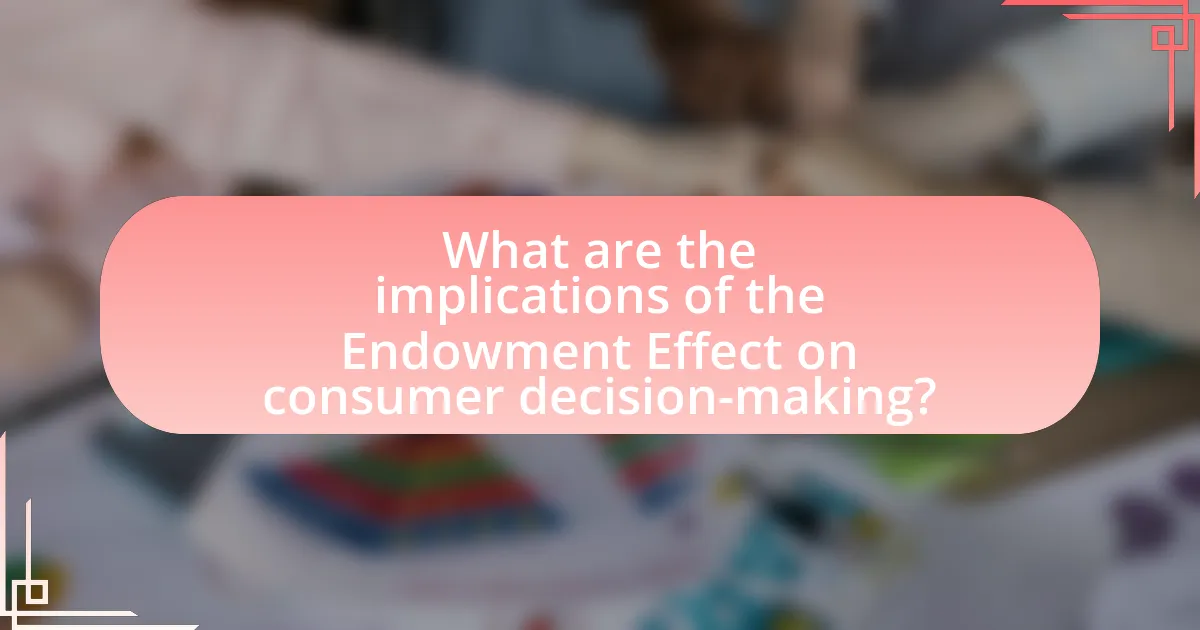
What are the implications of the Endowment Effect on consumer decision-making?
The Endowment Effect significantly influences consumer decision-making by causing individuals to assign greater value to items they own compared to identical items they do not own. This psychological bias leads consumers to overvalue their possessions, which can result in reluctance to sell or trade items, even when market conditions suggest a favorable transaction. Research by Kahneman, Knetsch, and Thaler in their 1990 study demonstrated that participants were willing to pay significantly more to retain an item they owned than they would pay to acquire the same item if they did not own it. This discrepancy illustrates how ownership can distort perceived value, ultimately affecting purchasing behavior and market dynamics.
How does the Endowment Effect affect consumer satisfaction?
The Endowment Effect increases consumer satisfaction by enhancing the perceived value of items once they are owned. This psychological phenomenon leads consumers to assign greater worth to possessions than to equivalent items they do not own, resulting in a heightened sense of satisfaction with their purchases. Research by Kahneman, Knetsch, and Thaler in 1990 demonstrated that individuals often demand significantly more to part with an item they own than they would be willing to pay to acquire it, illustrating how ownership can amplify satisfaction through emotional attachment and perceived loss aversion.
What are the long-term effects of the Endowment Effect on consumer loyalty?
The long-term effects of the Endowment Effect on consumer loyalty include increased retention rates and a heightened perceived value of owned products. When consumers perceive ownership of a product, they often develop a stronger emotional attachment, leading to a reluctance to switch brands or products. Research indicates that this attachment can result in consumers being willing to pay more for items they own compared to similar items they do not own, reinforcing brand loyalty over time. For instance, a study published in the Journal of Consumer Research found that consumers who feel a sense of ownership are less likely to consider alternatives, thus solidifying their loyalty to a brand.
How does the Endowment Effect relate to regret in purchasing decisions?
The Endowment Effect causes individuals to assign greater value to items they own compared to items they do not own, which directly influences feelings of regret in purchasing decisions. When consumers overvalue their possessions, they may experience regret if they perceive that they could have made a better choice or if they later realize that the item does not meet their expectations. Research by Kahneman, Knetsch, and Thaler in 1990 demonstrated that people are less willing to trade items they own for items of equal value, indicating that ownership increases perceived value and potential regret over decisions that lead to loss of ownership. This psychological phenomenon illustrates how the Endowment Effect can amplify regret, as individuals reflect on their purchasing choices and the perceived loss associated with giving up an owned item.
What are the limitations of the Endowment Effect in consumer behavior?
The limitations of the Endowment Effect in consumer behavior include its variability across different contexts, the influence of individual differences, and the potential for diminishing returns over time. Research indicates that the Endowment Effect is less pronounced in high-stakes situations or when consumers are under time pressure, as demonstrated in studies by Kahneman, Knetsch, and Thaler, which show that the effect can be mitigated by external factors. Additionally, individual differences such as personality traits and prior experiences can significantly impact the strength of the Endowment Effect, with some consumers exhibiting a stronger attachment to owned items than others. Furthermore, the Endowment Effect may weaken as the ownership duration increases, suggesting that consumers may eventually reassess their valuation of owned items.
How does the Endowment Effect vary across different demographics?
The Endowment Effect varies across different demographics, with factors such as age, gender, and cultural background influencing its intensity. Research indicates that younger individuals tend to exhibit a stronger Endowment Effect compared to older adults, likely due to differences in risk perception and decision-making styles. Additionally, studies show that men often display a more pronounced Endowment Effect than women, which may be linked to varying levels of competitiveness and ownership attachment. Cultural influences also play a significant role; for instance, collectivist cultures may exhibit a weaker Endowment Effect due to a greater emphasis on community and shared ownership. These demographic variations highlight the complexity of consumer behavior and the psychological factors that drive the Endowment Effect across different groups.
What situations diminish the Endowment Effect’s influence?
Situations that diminish the Endowment Effect’s influence include a lack of emotional attachment to the item, increased familiarity with alternatives, and the presence of objective valuation criteria. When individuals do not feel a strong personal connection to an item, they are less likely to overvalue it. Research indicates that when consumers are exposed to similar products or alternatives, their perceived value of the owned item decreases, as seen in studies where participants evaluated items in a competitive context. Additionally, when objective criteria, such as market prices or expert evaluations, are presented, individuals tend to rely on these external benchmarks rather than their subjective ownership feelings, further reducing the Endowment Effect’s impact.
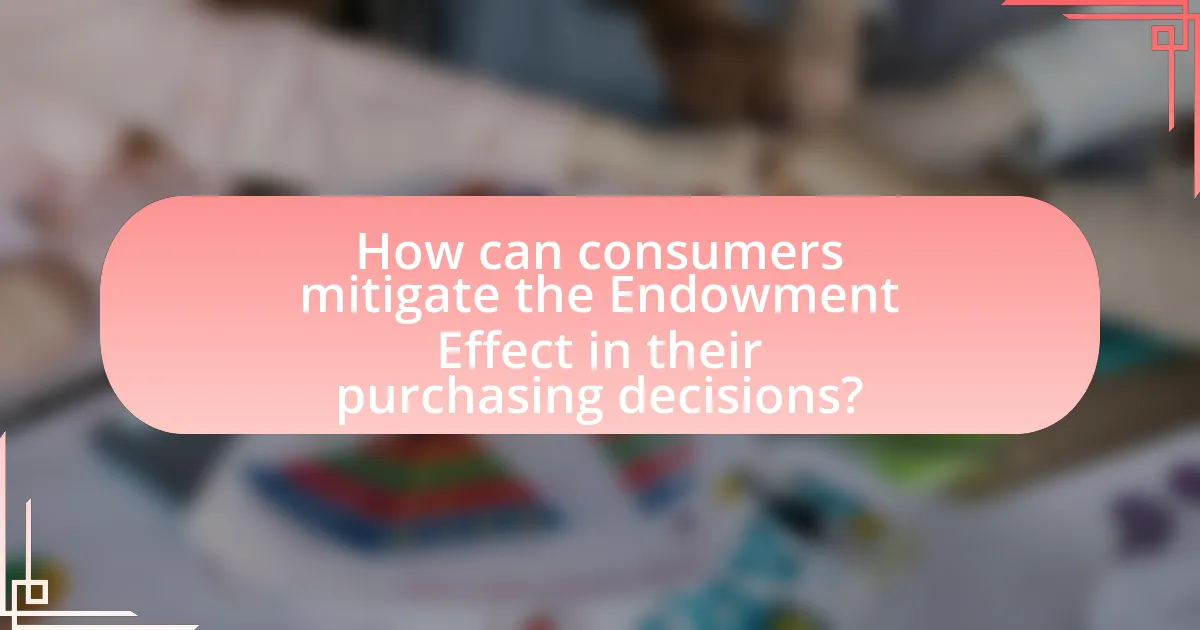
How can consumers mitigate the Endowment Effect in their purchasing decisions?
Consumers can mitigate the Endowment Effect in their purchasing decisions by actively reframing their perceptions of ownership. This involves consciously recognizing that the value they assign to an item may be inflated simply because they own it. Research indicates that when consumers focus on the objective benefits and utility of a product rather than their emotional attachment, they are less likely to overvalue it. For instance, a study published in the Journal of Consumer Research by Dan Ariely and Klaus Wertenbroch demonstrates that individuals who are prompted to consider the practical uses of an item tend to make more rational purchasing decisions, thereby reducing the influence of the Endowment Effect.
What strategies can consumers use to counteract the Endowment Effect?
Consumers can counteract the Endowment Effect by employing strategies such as reframing their perspective on ownership, conducting objective evaluations of items, and utilizing decision-making frameworks. Reframing involves viewing items as potential purchases rather than possessions, which helps diminish the emotional attachment that leads to the Endowment Effect. Objective evaluations can be achieved by comparing the item in question with alternatives, allowing consumers to assess its true value without the bias of ownership. Decision-making frameworks, such as cost-benefit analysis, encourage consumers to weigh the pros and cons of keeping versus selling an item, promoting rational decision-making over emotional bias. These strategies are supported by behavioral economics research, which indicates that reframing and objective assessments can significantly reduce the influence of the Endowment Effect on consumer behavior.
How can awareness of the Endowment Effect improve decision-making?
Awareness of the Endowment Effect can improve decision-making by enabling individuals to recognize their biases towards ownership, which often leads to overvaluing items they possess. This understanding allows consumers to make more rational choices by mitigating the emotional attachment that distorts their perception of value. Research by Kahneman, Knetsch, and Thaler in 1990 demonstrated that people tend to demand much higher prices to sell an item they own than they would be willing to pay to acquire it, illustrating the disparity caused by the Endowment Effect. By acknowledging this cognitive bias, individuals can better evaluate options and avoid poor financial decisions influenced by inflated valuations of owned items.
What practical tips can help consumers make more rational purchases?
Consumers can make more rational purchases by implementing strategies such as setting a budget, conducting thorough research, and delaying gratification. Setting a budget helps consumers limit their spending and prioritize needs over wants, which reduces impulsive buying. Conducting thorough research, including comparing prices and reading reviews, enables consumers to make informed decisions based on value rather than emotional attachment. Delaying gratification, such as waiting 24 hours before making a purchase, allows consumers to assess whether the item is truly necessary, mitigating the influence of the endowment effect, which can lead to overvaluing possessions. These strategies collectively promote more thoughtful and rational purchasing behavior.
